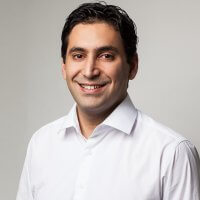Severe nearsightedness - high myopia Ophthalmological help for patients
Severe myopia – also called high myopia – can cause symptoms at any age. We recommend those affected who already have a slight form of myopia to pay special attention to the course of myopia through regular early detection measures in order to avoid deterioration.
Specialized ophthalmologists: Severe nearsightedness - high myopia
- Myopia increases the risk of retinal diseases . Our ophthalmological practice, in the heart of Düsseldorf, has specialized in the detection and treatment of myopia.
- We take a lot of time for our patients and offer special preventive checkups for high-risk patients .
Severe nearsightedness High myopia
Important questions and answers
What is high myopia?
High myopia or severe nearsightedness is expressed by very poor distance vision. From a value of minus 6 dioptres one speaks of high myopia. This severe nearsightedness increases the risk of retinal disease and glaucoma.
Who is affected by high myopia?
The high form of myopia is a worldwide common disease that is developed by around 50,000 people each year. In Germany, around one to three percent of the population is currently affected. The high myopia can occur at any age.
What are the causes of high myopia?
With myopia, the patient’s eyeball is too long. The causes responsible for this, also with regard to the progression of myopia, have not yet been adequately researched. We recommend that you carry out regular preventive examinations.
Symptoms of high myopia
Nearsighted people see sharply up close, but out of focus in the distance. With healthy eyesight, rays of light falling parallel into the eye form their focal point precisely on the retina. In the case of nearsightedness, this point is already in front of it. That is why objects in the vicinity are seen clearly and objects in the distance are only seen blurred. Sharp vision deteriorates with distance.
This eye disease turns into severe nearsightedness when the necessary correction value reaches or exceeds -6 diopters. The reason for tis high value is that the eyeball (Bulbus oculi) in this case measures more than 26 millimeters in length. This is a deviation of at least two millimeters more than in people with normal vision.

Myopia can be recognized in everyday life when you have to squint your eyes when looking into the distance in order to see more clearly.
Risk factors for severe myopia
The preliminary stage of high myopia is myopia. This poor vision can worsen and develop into severe myopia. Myopia is therefore a risk factor in general. It can actually occur at any age. Usually, patients under the age of 50 are most often affected.
In order to avoid undetected progression of this eye disease, we recommend having regular preventive examinations carried out by the ophthalmologist from the diagnosis of simple myopia on.
Complications in the course of high myopia
-
Pathological myopia
A rare, severe form of myopia that can cause further damage.
-
Macular degeneration caused by myopia
Macular degeneration as a result of severe myopia.
-
Myopia astigmatism
Severe nearsightedness in combination with a corneal curvature.
-
Myopia cataract
Myopia as a symptom of age-related cataracts.
-
Myopia retinal detachment
Detachment of the retina due to high myopia.
-
Myopic Choroidal Neovascularizations CNV
A new formation of diseased blood vessels based on severe nearsightedness, starting from the choroid.
Find out more about the forms and characteristics of high myopia .
High myopia - examination by the ophthalmologist
We offer various diagnostic methods to examine the status of high myopia. A classic eye test is used to determine the diopter value. This provides information about the degree of myopia. Since the retina and its vessels can also be affected in high myopia, we also use OCT, wide-angle images and, if necessary, angiography for a precise diagnosis of the condition of the eye.
Diagnosis and treatment of severe myopia
Severe myopia cannot be cured, but it can be treated. By correcting the visual impairment, those affected can be helped.
-
Visual aids for severely myopic patients
Thanks to modern correction options, severely short-sighted patients no longer have to resort to wide glasses frames with thick lenses. Modern cuts now offer thinner lenses and fashionable glasses for severely myopic people to correct their poor eyesight. Contact lenses can also help those affected. Professional measurement of the required values is important for both glasses and contact lenses.
-
Laser treatment of the eyes for severe myopia
In the case of a retinal hole or retinal degeneration, therapy with the laser is essential to prevent retinal detachment and the associated blindness.
-
Injection therapy for high myopia
It is also possible to treat pathological neovascularization (CNV = choroidal neovascularization), which can occur in cases of high myopia, by injecting medication into the eye. This therapy enables the patient’s progressive loss of vision to be halted and has good chances to provide visual improvement.
Further information on myopia and nearsightedness
Don't be afraid of the ophthalmologist!
Our ophthalmological practice specializes in the detection and treatment of retinal diseases. We use the latest technologies in ophthalmic medicine, work very sensitively, absolutely sterile and particularly precisely, so that examinations and treatment can be experienced quickly and painlessly.



